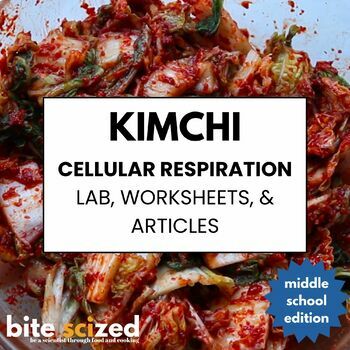Explore Microbes, Cellular Respiration & Ecosystems through Kimchi Lab & Lesson
- Google Drive™ folder

Description
In this 4-6 day lesson, students explore microbes, cellular respiration, and environmental factors in ecosystems by making and observing kimchi over time.
Essential Questions:
- What is kimchi and how is it made?
- How does kimchi change over time as it sits?
- How can we influence the growth of microbes [LAB] in kimchi?
You can learn more details about the exact materials needed for this lesson and labs, as well as the timing of each lab, at our website: www.bitescized.org. Go to https://www.bitescized.org/lessonlibrary.
In this Google Drive folder, you will find…
- 01. Lesson Plan. Includes:
- Essential Questions, Objectives, NGSS standards
- Lab Prep Information (Materials, Ingredients, Amazon Lists, Tips)
- Lesson Flow & Day-by-Day Lesson Plans
- 02. Classroom Slides (intended for presentation to students). Includes:
- Directions for lesson flow, turn and talk prompts, illustrations and graphics, embedded videos, and whole group reflection questions
- 03. Student Handouts. Most handouts are in one large document that has a clickable table of contents linking to each handout.
- Most of our lessons also include some form of assessment like a CER (claim-evidence-response) or modeling activity. We also include a rubric for teachers to use for assessment at the end of the lesson.
- 04. Anchor Reading, Infographic, or Other Data. Most of our lessons include an anchor reading, which explains key science concepts specific to the lesson and food. It also includes relevant research, models, and illustrations. Learn more about thesehere</a>.
Instructional Lab & Science Behind Videos: We also create and produce videos to show step-by-step instructions for labs and explain science concepts. Relevant YouTube videos will be linked throughout these documents and can also Within all documents, we link to our YouTube videos, which can also be found on ourYouTube channel</a>.
NOTE: While this lab is certainly ideal to do for the full experience, you do not have to do the lab. Students can still learn a lot by watching the video and completing the supplemental materials.


